
- •Lesson (1) Chromosomes and genetic information
- •Remember
- •Remember
- •Importance of crossing over:-
- •Lesson (2) The interaction of genes
- •Remember
- •Remember
- •Inheritance of blood groups in human
- •For illustration only
- •Inheritance of colour trait in mice
- •Inheritance of chlorophyll absence trait in corn plant
- •Lesson (3) Genetic inheritance and diseases
- •Importance of pedigree
- •Answer four questions only
Importance of pedigree
1- It explains how a certain trait is inherited in a certain family
2- It is used to trace different hereditary traits (especially those linked to genetic diseases and disorders)
3- It is used for prediction of the probability of appearance of these traits in coming generations.
The following chart describes pedigree of a family
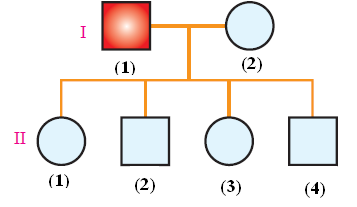
Fig. (12) Pedigree chart
- Male individuals are denoted by squares
- Female individuals are denoted by circles
- Mating (marriage) is symbolized by a line joining between the circle and square
- Offspring is symbolized by a vertical line extending from that of marriage
- Every generation is given a Roman number ( I – II – II – V…etc)
- Every individual is given a number, in order to facilitate finding it
- Shaped which are studies are coloured (in the previous chart, father (1) of generation (I) is the individual being studied)
The study of genetic cases in human
1- Albinism ( also called Albino or Sun enemy)
Albinism: Genetic disorder which causes the absence of melanin pigments from the cells of hair, eye lashes and skin.
Albinism is caused by the recessive gene (a)

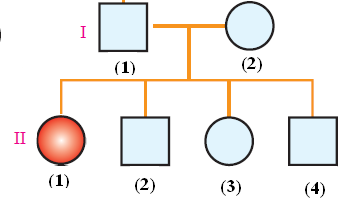
Fig. (13) Pedigree chart of albinism Fig. (14) Child with Albinism
Probable genotypes of this family members are:-
Generation (I)
1- Aa 2- Aa
Generation (II)
1- aa 2- AA or Aa 3- AA or Aa 4- AA or Aa
2-Polydactyl
Polydactyl: Genetic disorder in which human has sixth fingers (instead of five), it is caused by a dominant gene
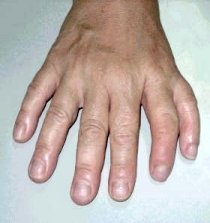
Fig. (14) Polydactyl genetic disorder
B- Gene maps (DNA analysis)
Scientists succeeded in creating a map of all human genes.
This map can help us determine the diseases with by which human may be infected in the future.
C- Amniotic fluid testing during pregnancy
Amniotic fluid: The fluid which surrounds the fetus in a pregnant female
Examining the chromosomes of fetus cells in amniotic fluid helps us determine the diseases caused by the increase or decrease of the no. of chromosomes (Ex. Down syndrome – Klinefelter's syndrome – Turner's syndrome), as we can get photos of these chromosomes and make Karyotype for the fetus.
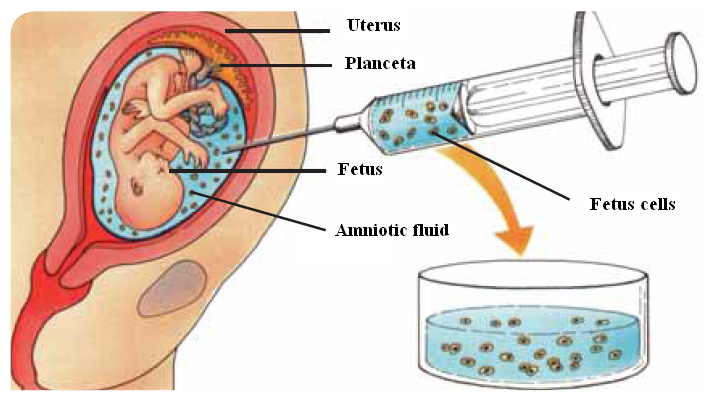
Fig. (15) Amniotic fluid testing
![]()
Medical test before marriage is a group of medical tests which are carried out by the couple before they marry
Medical tests make sure they are not infected by contagious diseases ( such as hepatitis and Acquired immunity deficiency syndrome (AIDS) ) or genetic diseases (Such as Thalassemia), which predicts the probability of the transfer of the disease to the other mate or children , and gives choices and advises to the couple in order to help them make a healthy family.
Factors of genetic diseases spread
1- Relatives marriage
2- Getting married without carrying out medical tests
The importance of medical tests
Medical tests help in:-
- Having healthy children
- Limiting the spread of genetic diseases, congenital disorders and mental retardation
- Avoiding social, psychological and financial problems resulted from taking care
of children with genetic diseases.
![]()
The DNA fingerprint (DNA typing)
In 1984, Dr. Alec Jeffreys(genetics scientist Leicester university in London) published a research in which he explained that the hereditary material may be repeated many times. After one year, he discovered that every person has unique sequences. These sequences cannot be the same in any two persons(except for identical twins). "Alec" patented his discovery in 1985 and called these sequences The DNA fingerprint
The DNA fingerprint: A method used to recognize a person by the comparison of his DNA sequences
The importance of DNA fingerprint
Field of medicine:-
- Used in the study of genetic diseases
- Used in tissues transplantation process
Field of forensics
- It helps in recognizing deformed dead bodies and tracking lost children
- It helped courts begin investigations in crimes whose offenders were unknown.
- It acquitted hundreds of people who were accused of rape and murder crimes and convicted others
- It plays an important role in parentage cases
Human genome
Human genome contains all genes which exist in the nucleus of somatic cell
There are from 60,000 to 80,000 genes in nucleus, these genes are carried on 23 pairs of chromosomes. These genes cause the appearance of all these numerous human traits.
In 1953, scientists Watson and Creek discovered that genes are carried on a double helix of DNA.
In 1980, the idea of genome emerged. In that time, the number of discovered human genes was only 450 genes, in middle 80's the number of discovered genes became 1500. Scientists aimed to draw a genome map by determining the locations of genes on chromosomes, which would help them determine genes causing genetic diseases
The importance of genome
Scientists aim to use genome in :-
- The manufacture of drugs without side effects
- The study of evolution of living organisms by comparing human genome to that of other organisms
- Improving offspring by determining the genes causing diseases in the fetus before its birth and improving them.
![]()
Klinefelter's syndrome: Genetic disorder caused by the increase of sex chromosome (X) in some males (XXY + 44)
Turner's syndrome: Genetic disorder caused by the decrease of chromosome (X) in some females (XO+44)
Down's syndrome: Genetic disorder caused by the existence of an additional chromosome in chromosome pair (21)
Sex-linked traits: They are traits whose genes are carried on sex chromosomes , but their appearance is not affected by sex hormones.
Sex-influenced traits: They are traits whose genes are carried on somatic chromosomes, and their appearance is affected by sex hormones.
Hemophilia: Genetic disease which causes the inability of body to control blood clotting process – the process which stops bleeding
Sex-limited traits: They are traits which appear in one of the two sexes only due to the difference in sex hormones
Albinism: Genetic disorder which causes the absence of melanin pigments from the cells of hair, eye lashes and skin
Pedigree: Diagram which represents hereditary data which explains how a certain trait is inherited, and used in tracing different hereditary traits
DNA fingerprint: A method used to recognize a person by the comparison of his DNA sequences
![]()
1- A Sperm determines the sex of fetus not ovum
Because there are two kinds of sperms – a kind carrying (X) sex chromosome and another one carrying (Y) sex chromosome, while ova have only one kind (which carries X sex chromosome). When a sperm carrying (Y) chromosome fertilizes an ovum of (X) chromosome, a male fetus (XY) is formed, while when a sperm of (X) chromosome fertilizes an ovum, a female fetus (XX) is formed.
2- A male with Klinefelter's syndrome is infertile and has feminine traits
Because it has an additional (X) sex chromosome in his Karyotype, which causes the disorder of sex hormones, as there are female sex hormones on (X) chromosome
3- A female with Turner's syndrome cannot hit puberty
Due to the lack of female sex hormones responsible for puberty, as this female has only one (X) sex chromosome instead of two.
4- Klinefelter's syndrome affects males only
Because Klinefelter's syndrome is caused when an abnormal ovum having 2 (X) chromosome (XX+22) is fertilized by a sperm (Y+22), which forms a male zygote of Karyotype (XXY+44)
5- Turner's syndrome affects females only
Because Turner's syndrome is caused when an abnormal ovum with no X chromosomes (O+22) is fertilized by a sperm (X+22), which forms a female zygote of Karyotype (XX+44).
6- Eye colour of Drosophila insect is from sex-linked traits
Because eye colour trait of Drosophila insect exists on sex chromosomes, and not affected by sex hormones
7- Colour blindness is more common in males than females
Because colour blindness trait gene is carried on one (X) sex chromosome in males, while it has two genes carried on (XX) sex chromosomes in females. And as we know, a males carries only one (X) chromosome, while a woman carries two (X) chromosomes, so colour blindness is more common in men.
8- Males cannot inherit colour blindness from their fathers
Because they inherit sex chromosomes (Y) from father, not chromosome (X) on which colour blindness gene is carried.
9- Both females and males can inherit colour blindness from their mothers
Because both of them inherit chromosome (X) from mother – the chromosome on which colour blindness gene is carried
10- A man with genotype (B+B) is infected with baldness, while a female with the same genotype has normal hair
Because baldness is from sex-influenced traits, so its gene is only affected by male sex hormones
11- Scientists find it hard to study the inherited traits and how they transfer to human.
Due to:-
- The long time between a generation and another one
- The small number of individuals resulted from every marriage
12- Pedigree is from the most important methods in human genetics
Because:-
1- It explains how a certain trait is inherited in a certain family
2- It is used to trace different hereditary traits (especially those linked to genetic diseases and disorders)
3- It is used for prediction of the probability of appearance of these traits in coming generations
13- The importance of DNA analysis (gene map)
Because this map can help us determine the diseases with by which human may be infected in the future.
14- The spread of genetic diseases and disorders
Due to:-
1- Marriage of relatives
2- Getting married without carrying out medical tests
15- The importance of carrying out medical tests before marriage
Because medical tests help in:-
- Having healthy children
- Limiting the spread of genetic diseases, congenital disorders and mental retardation
- Avoiding social, psychological and financial problems resulted from taking care
of children with genetic diseases
16- DNA fingerprint plays an important role in the field of medicine
Because:-
- It is used in the study of genetic diseases
- It is used in tissues transplantation process
17- Amniotic fluid testing is very important during pregnancy
Because it helps us determine the diseases caused by the increase or decrease of the no. of chromosomes (Ex. Down syndrome – Klinefelter's syndrome – Turner's syndrome), as we can get photos of these chromosomes and make Karyotype for the fetus.
18- The importance of DNA fingerprint in forensic science
Because:-
- It helps in recognizing deformed dead bodies and tracking lost children
- It helped courts begin investigations in crimes whose offenders were unknown.
- It acquitted hundreds of people who were accused of rape and murder crimes and convicted others
- It plays an important role in parentage cases
19- The importance of genome in human genetics
Because scientists aim to use genome in :-
- The manufacture of drugs without side effects
- The study of evolution of living organisms by comparing human genome to that of other organisms
- Improving offspring by determining the genes causing diseases in the fetus before its birth and improving them
![]()
1- A sperm (Y+22) fertilizes an ovum (X+22)
A male zygote (XY+44) is formed
2- A sperm (X+22) fertilizes an ovum of the same Karyotype
A female zygote (XX+44) is formed
3- A sperm (Y+22) fertilizes an abnormal ovum (XX+22)
A male fetus (XXY+44) suffering from Klinefelter's syndrome is formed, which makes him infertile and causes the appearance of some feminine traits, tall stature, growth of limbs more than average rate and mental retardation due to the disorder of sex hormones.
4- A sperm (X+22) fertilizes an abnormal ovum (O+22)
A female fetus (XO+22) suffering from Turner's syndrome is formed, which makes her unable to hit puberty due to the lack of hormones and causes short stature, slow mental development, and congenital disorders in heart and kidneys.
5- The fertilization of a gamete carrying a complete pair of chromosome in pair (21)
A male fetus (XY+45) or female fetus (XX+45) suffering from Down syndrome is formed (because of having 3 copies of chromosome 21), which causes mental retardation, short stature, oval face, flat head back, short fingers and toes, small ears and narrow eyes

Sex- limited traits |
Sex-influenced traits |
Sex-linked traits |
Point of comparison |
They are traits which appears in one of the two sexes only due to the difference in sex hormone |
They are traits whose genes are carried on somatic chromosomes, and their appearance is affected by sex hormone |
They are traits whose genes are carried on sex chromosomes , but their appearance is not affected by sex hormone |
Definition |
Milk production n females |
Baldness / Hemophilia |
Eye colour of Drosophila |
Examples |
Turner's syndrome |
Klinefelter's syndrome |
Down syndrome |
Point of comparison |
(XO+44) |
(XXY + 44) |
(XX + 45) or (XY+45) |
Karyotype |
The fertilization of an abnormal ovum (O+22) by a sperm (X+22) |
The fertilization of an abnormal ovum (XX+22) by a sperm (Y+22) |
The fertilization of a gamete carrying a complete pair of chromosome (21) |
Causes |
- Female's inability to hit puberty - Congenital disorders in kidneys and heart - Short stature |
- Infertile male - The appearance of feminine traits (growth of breast) - Tall stature - Mental retardation - Overgrowth of limbs
|
- Mental retardation - Narrow eyes - Short stature - Short toes and fingers - Flat head back - Delayed growth - Oval face - Small ears |
Symptoms
|
![]()
1- Choose the correct answer
1- The Karyotype of male cell is …………….
A- XX + 44 B- XY+44 C- XO + 44 D- XXY + 44
2- The Karyotype of female cell is ………
A- XX + 44 B- XY+44 C- XO + 44 D- XXY + 44
3- Karyotype of Klinefelter's syndrome is …….
A- XXY + 44 B- XO +44 C- YO + 45 D- XY + 45
4- Karyotype of Turner's syndrome is …………….
A- XXY + 44 B- XO +44 C- YO + 45 D- XY + 45
5- Down syndrome is caused by the fertilization of an ovum (X+22) with sperm
A- X + 23 B- Y + 23 C- X + 22 D- Y+22
6- ………. affects males only
A- Turner's syndrome B- Klinefelter's syndrome C- Down syndrome
D- Hepatitis
7- ……… affects females only
A- Turner's syndrome B- Klinefelter's syndrome C- Down syndrome
D- Hepatitis
8- ………. is also known as Mongolism
A- Turner's syndrome B- Klinefelter's syndrome C- Down syndrome
D- Hemophilia
9- The eye colour of Drosophila insect is an example on ……….. traits
A- Sex-linked B- Sex-influenced C- Sex-limited D- Mendilian
10- Colour blindness trait is an example on ………….. traits
A- Sex-linked B- Sex-influenced C- Sex-limited D- Mendilian
11- When a sound male and a female infected with colour blindness marry, the appearance of this case will be in …………..
A- All males B- All females C- Half the males D- Half the females
12- Hemophilia is an example on ………….. traits
A- Sex-linked B- Sex-influenced C- Sex-limited D- Mendilian
13- Growth of beards in males in an example on ………. Traits
A- Sex-linked B- Sex-influenced C- Sex-limited D- Mendilian
14- Genetic disorder which causes the absence of melanin pigments in human body is called ………..
A- Albinism B- Hemophilia C- Polydactyl D- Baldness
15- DNA fingerprint was discovered by scientist ……..
A- Gregory Mendel B- Watson and Creek C- T. Morgan D- Alec Jeffreys
2- Write the scientific term
1- Genetic disorder caused by the increase of sex chromosome (X) in some males (XXY + 44)
2- Genetic disorder caused by the decrease of chromosome (X) in some females (XO+44)
3- Genetic disorder caused by the existence of an additional chromosome in chromosome pair (21)
4- They are traits whose genes are carried on sex chromosomes , but their appearance is not affected by sex hormones.
5- They are traits whose genes are carried on somatic chromosomes, and their appearance is affected by sex hormones.
6- Genetic disease which causes the inability of body to control blood clotting process – the process which stops bleeding
7- They are traits which appear in one of the two sexes only due to the difference in sex hormones
8- Genetic disorder which causes the absence of melanin pigments from the cells of hair, eye lashes and skin
9- Diagram which represents hereditary data which explains how a certain trait is inherited, and used in tracing different hereditary traits
10- A method used to recognize a person by the comparison of his DNA sequences
3- Write short notes about
1- Sex-linked traits
2- Sex-influenced traits
3- Sex- limited traits
4- Turner's syndrome
5- Klinefelter's syndrome
6- Down syndrome
7- Genome
8- DNA fingerprint
4- Study the following figure and answer the questions
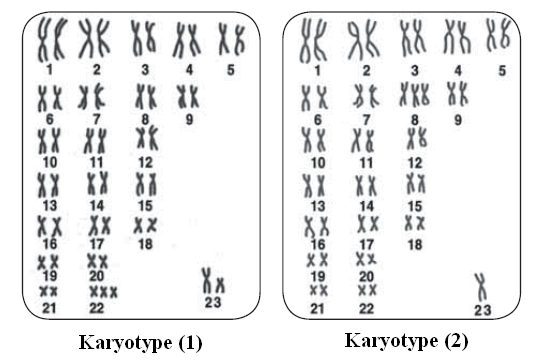
1- What is the number of chromosomes in karyotypes (1) and (2)?
2- What are the sexes of the individuals carrying karyotypes (1) and (2)?
3- What is the name, causes and symptoms of the abnormal condition in karyotype (1)?
4- What is the name, causes and symptoms of the abnormal condition in karyotype (2)?
5- The following pedigree chart describe the ability to roll tongue trait, answer the questions
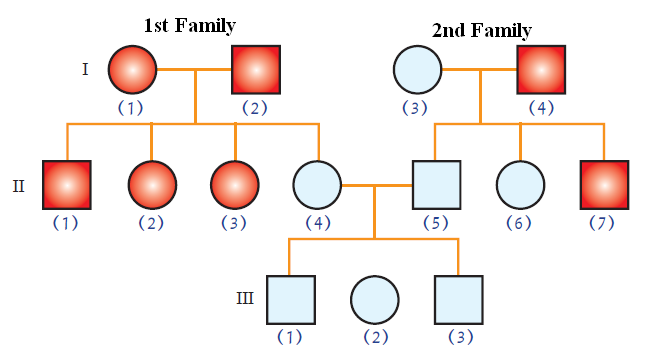
1- Is this trait dominant or recessive? Why?
2- What are the genotypes of the following individuals
I (1)
I (3)
II (3)
II (5)
III (1)
6- The following pedigree charts describe the inheritance of Hemophilia trait, answer the following questions

1- Is this trait dominant or recessive?
2- Write the genotypes of the following individuals
I (1)
I (2)
II (1)
II (5)
III (1)
![]()
1- Choose the correct answer
1- XY+44 7- Turner's syndrome
2- XX + 44 8- Down syndrome
3- XXY + 44 9- Sex-linked
4- XO +44 10- Sex-linked
5- Y + 23 11- All males
6- Klinefelter's syndrome 12- Sex-linked
13- Sex-limited 14- Albinism
15- Alec Jeffreys
2- Write the scientific term
1- Klinefelter's syndrome 6- Hemophilia
2- Turner's syndrome 7- Sex-limited traits
3- Down syndrome 8- Albinism
4- Sex-linked chromosomes 9- Pedigree chart
5- Sex-influenced chromosomes 10- DNA fingerprint
4- Study the following figure and answer the questions
1- Karyotype (1): 47 chromosomes – Karyotype (2): 45 Chromosomes
2- Karyotype (1): Male – Karyotype (2): Female
3- Name: Down syndrome
Cause: Fertilization of a gamete having a complete pair of chromosomes 21
Symptoms: Mental retardation – Delayed growth – Oval face – Narrow eyes – Short stature – Small ears – Flat head back – Short fingers and toes
4- Name: Turner's syndrome
Cause: Fertilization of an abnormal ovum (XO+22) by a sperm (X+22)
Symptoms: Short stature – Inability to hit puberty – Congenital disorders in heart and kidneys
5-
1- Rolling tongue trait is dominant because it appeared in all members of 1st generation in the first family at ratio 100%, and 2nd generation at ratio 75%
2-
I (1) Bb
I (3) bb
II (3) BB or Bb
II (5) bb
III (1) bb
6-
1- Recessive
2-
I (1) AA
I (2) aa
II (4) Aa
II (5) Aa
III (1) aa
![]()
